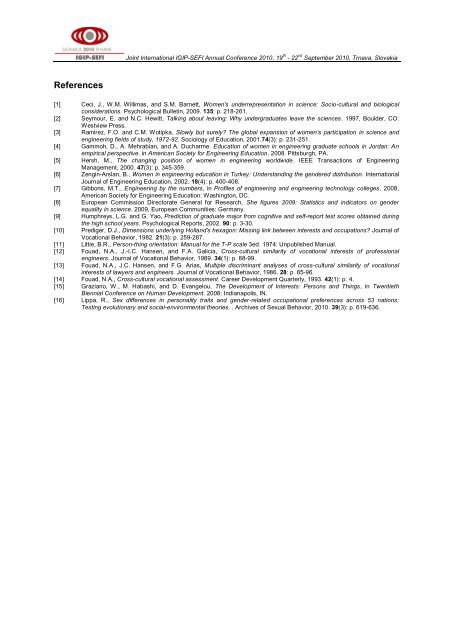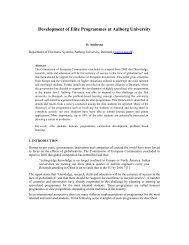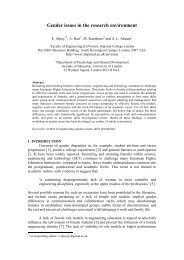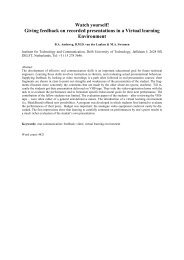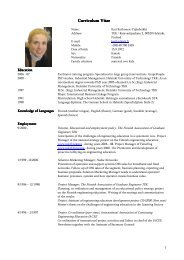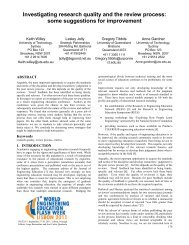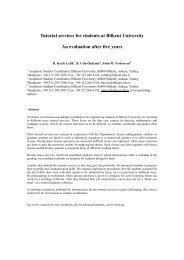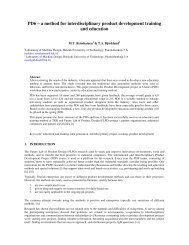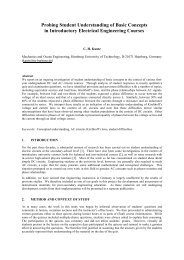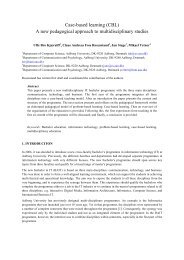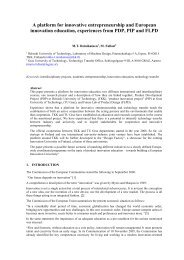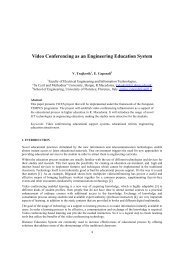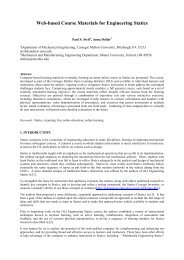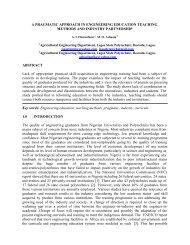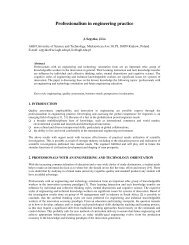1250 - SEFI
1250 - SEFI
1250 - SEFI
Create successful ePaper yourself
Turn your PDF publications into a flip-book with our unique Google optimized e-Paper software.
Joint International IGIP-<strong>SEFI</strong> Annual Conference 2010, 19 th - 22 nd September 2010, Trnava, Slovakia<br />
References<br />
[1] Ceci, J., W.M. Willimas, and S.M. Barnett, Women's underrepresentation in science: Socio-cultural and biological<br />
considerations. Psychological Bulletin, 2009. 135: p. 218-261.<br />
[2] Seymour, E. and N.C. Hewitt, Talking about leaving: Why undergraduates leave the sciences. 1997, Boulder, CO:<br />
Westview Press.<br />
[3] Ramirez, F.O. and C.M. Wotipka, Slowly but surely? The global expansion of women’s participation in science and<br />
engineering fields of study, 1972-92. Sociology of Education, 2001.74(3): p. 231-251.<br />
[4] Gammoh, D., A. Mehrabian, and A. Ducharme. Education of women in engineering graduate schools in Jordan: An<br />
empirical perspective. in American Society for Engineering Education. 2008. Pittsburgh, PA.<br />
[5] Hersh, M., The changing position of women in engineering worldwide. IEEE Transactions of Engineering<br />
Management, 2000. 47(3): p. 345-359.<br />
[6] Zengin-Arslan, B., Women in engineering education in Turkey: Understanding the gendered distribution. International<br />
Journal of Engineering Education, 2002. 18(4): p. 400-408.<br />
[7] Gibbons, M.T., Engineering by the numbers, in Profiles of engineering and engineering technology colleges. 2008,<br />
American Society for Engineering Education: Washington, DC.<br />
[8] European Commission Directorate General for Research, She figures 2009: Statistics and indicators on gender<br />
equality in science. 2009, European Communities: Germany.<br />
[9] Humphreys, L.G. and G. Yao, Prediction of graduate major from cognitive and self-report test scores obtained during<br />
the high school years. Psychological Reports, 2002. 90: p. 3-30.<br />
[10] Prediger, D.J., Dimensions underlying Holland's hexagon: Missing link between interests and occupations? Journal of<br />
Vocational Behavior, 1982. 21(3): p. 259-287.<br />
[11] Little, B.R., Person-thing orientation: Manual for the T-P scale 3ed. 1974: Unpublished Manual.<br />
[12] Fouad, N.A., J.-I.C. Hansen, and F.A. Galicia, Cross-cultural similarity of vocational interests of professional<br />
engineers. Journal of Vocational Behavior, 1989. 34(1): p. 88-99.<br />
[13] Fouad, N.A., J.C. Hansen, and F.G. Arias, Multiple discriminant analyses of cross-cultural similarity of vocational<br />
interests of lawyers and engineers. Journal of Vocational Behavior, 1986. 28: p. 85-96.<br />
[14] Fouad, N.A., Cross-cultural vocational assessment. Career Development Quarterly, 1993. 42(1): p. 4.<br />
[15] Graziano, W., M. Habashi, and D. Evangelou, The Development of Interests: Persons and Things, in Twentieth<br />
Biennial Conference on Human Development. 2008: Indianapolis, IN.<br />
[16] Lippa, R., Sex differences in personality traits and gender-related occupational preferences across 53 nations:<br />
Testing evolutionary and social-environmental theories. . Archives of Sexual Behavior, 2010. 39(3): p. 619-636.


